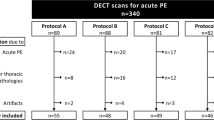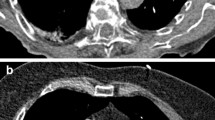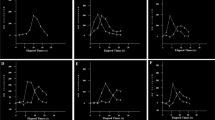Abstract
The definitive diagnosis of pulmonary embolism, a significant cause of morbidity and mortality, relies on imaging. In this study, we compare the conventional computed tomography pulmonary angiogram (CTPA) protocol to a double-rule out CT angiogram (DRO CTA) protocol in terms of vascular enhancement, radiation dose, and contrast volume delivered. The CTPA protocol involves injection of a timing bolus for localization of the pulmonary artery, whereas the DRO CTA protocol involves a biphasic contrast. We analyzed 248 consecutive CTPA studies and 242 consecutive DRO CTA studies. Vessel enhancement using region of interest (ROI) measurements, radiation dose delivered, and total contrast volume administered was recorded. The enhancement of all vessels measured was statistically significantly higher with the biphasic DRO CTA protocol than the CTPA protocol. The difference in mean vascular enhancement for the two protocols was greatest in the descending aorta (DA, P < 0.001) and least in the main pulmonary artery (MPA, P = 0.001). The percent of studies with vascular enhancement ≥250 Hounsfield units (HU) was significantly greater in all vascular beds except the MPA when the DRO CTA protocol was used. Studies performed with the DRO CTA protocol led to less radiation exposure and used less contrast than those performed with the CTPA protocol (P < 0.001 for both). According to the final radiology report, 35.08 % of studies in the CTPA group and 22.31 % of studies in the DRO CTA group were considered indeterminate (P = 0.001). In conclusion, the biphasic DRO CTA protocol leads to statistically significantly higher opacification of all pulmonary arterial and aortic vessels studied, with no greater delivery of radiation or contrast, than the monophasic CTPA protocol.




Similar content being viewed by others
References
Anderson FA, Wheeler HB, Goldberg RJ et al (1991) A population-based perspective of the hospital incidence and case-fatality rates of deep vein thrombosis and pulmonary embolism. the Worcester DVT study. Arch Intern Med 151:933–8
Heit JA, Rooke TW, Silverstein MD et al (2001) Trends in the incidence of venous stasis syndrome and venous ulcer: a 25-year population-based study. J Vasc Surg 33:1022–7. doi:10.1067/mva.2001.113308
Goldhaber SZ, Visani L, De Rosa M (1999) Acute pulmonary embolism: clinical outcomes in the international cooperative pulmonary embolism registry (ICOPER). Lancet 353:1386–9
Bettmann MA, Baginski SG, White RD et al (2012) ACR Appropriateness Criteria® acute chest pain–suspected pulmonary embolism. J Thorac Imaging 27:W28–31. doi:10.1097/RTI.0b013e31823efeb6
Remy-Jardin M, Remy J, Wattinne L, Giraud F (1992) Central pulmonary thromboembolism: diagnosis with spiral volumetric CT with the single-breath-hold technique–comparison with pulmonary angiography. Radiology 185:381–7. doi:10.1148/radiology.185.2.1410342
Garg K, Welsh CH, Feyerabend AJ et al (1998) Pulmonary embolism: diagnosis with spiral CT and ventilation-perfusion scanning–correlation with pulmonary angiographic results or clinical outcome. Radiology 208:201–8. doi:10.1148/radiology.208.1.9646814
Mayo JR, Remy-Jardin M, Müller NL et al (1997) Pulmonary embolism: prospective comparison of spiral CT with ventilation-perfusion scintigraphy. Radiology 205:447–52. doi:10.1148/radiology.205.2.9356627
Blachere H, Latrabe V, Montaudon M et al (2000) Pulmonary embolism revealed on helical CT angiography: comparison with ventilation-perfusion radionuclide lung scanning. AJR Am J Roentgenol 174:1041–7. doi:10.2214/ajr.174.4.1741041
Remy-Jardin M, Remy J, Baghaie F et al (2000) Clinical value of thin collimation in the diagnostic workup of pulmonary embolism. AJR Am J Roentgenol 175:407–11. doi:10.2214/ajr.175.2.1750407
Coche E, Verschuren F, Keyeux A et al (2003) Diagnosis of acute pulmonary embolism in outpatients: comparison of thin-collimation multi-detector row spiral CT and planar ventilation-perfusion scintigraphy. Radiology 229:757–65. doi:10.1148/radiol.2293020889
Henk CB, Grampp S, Linnau KF et al (2003) Suspected pulmonary embolism: enhancement of pulmonary arteries at deep-inspiration CT angiography–influence of patent foramen ovale and atrial-septal defect. Radiology 226:749–55. doi:10.1148/radiol.2263012200
Cereser L, Bagatto D, Girometti R et al (2011) Chest multidetector computed tomography (MDCT) in patients with suspected acute pulmonary embolism: diagnostic yield and proportion of other clinically relevant findings. Radiol Med 116:219–29. doi:10.1007/s11547-010-0612-2
Grishina A, Haramati LB, Hoppenfeld B, Freeman LM (2002) Utilization of CT-PA in an emergency department with readily available V/Q scintigraphy. Emerg Radiol 9:75–8. doi:10.1007/s10140-002-0197-8
Costa AF, Basseri H, Sheikh A et al (2014) The yield of CT pulmonary angiograms to exclude acute pulmonary embolism. Emerg Radiol 21:133–41. doi:10.1007/s10140-013-1169-x
Jones SE, Wittram C (2005) The indeterminate CT pulmonary angiogram: imaging characteristics and patient clinical outcome. Radiology 237:329–37. doi:10.1148/radiol.2371041520
Heyer CM, Mohr PS, Lemburg SP et al (2007) Image quality and radiation exposure at pulmonary CT angiography with 100- or 120-kVp protocol: prospective randomized study. Radiology 245:577–83. doi:10.1148/radiol.2452061919
Becker CR, Hong C, Knez A et al (2003) Optimal contrast application for cardiac 4-detector-row computed tomography. Invest Radiol 38:690–4. doi:10.1097/01.rli.0000084886.44676.e4
Chen YH, Velayudhan V, Weltman DI et al (2008) Waiting to exhale: salvaging the nondiagnostic CT pulmonary angiogram by using expiratory imaging to improve contrast dynamics. Emerg Radiol 15:161–9. doi:10.1007/s10140-007-0695-9
Platt JF, Reige KA, Ellis JH (1999) Aortic enhancement during abdominal CT angiography: correlation with test injections, flow rates, and patient demographics. AJR Am J Roentgenol 172:53–6. doi:10.2214/ajr.172.1.9888738
Bae KT (2003) Peak contrast enhancement in CT and MR angiography: when does it occur and why? pharmacokinetic study in a porcine model. Radiology 227:809–16. doi:10.1148/radiol.2273020102
Acknowledgments
The first author would like to thank the Poncin Scholarship Research Foundation for funding the time during which the research was conducted.
Conflict of interest
The authors declare that they have no conflict of interest.
Author information
Authors and Affiliations
Corresponding author
Rights and permissions
About this article
Cite this article
Cornea, A.M., McCullough, B.J., Mitsumori, L.M. et al. Enhancement of the pulmonary arteries and thoracic aorta: comparison of a biphasic contrast injection and fixed delay protocol with a monophasic injection and a timing bolus protocol. Emerg Radiol 22, 231–237 (2015). https://doi.org/10.1007/s10140-014-1269-2
Received:
Accepted:
Published:
Issue Date:
DOI: https://doi.org/10.1007/s10140-014-1269-2




